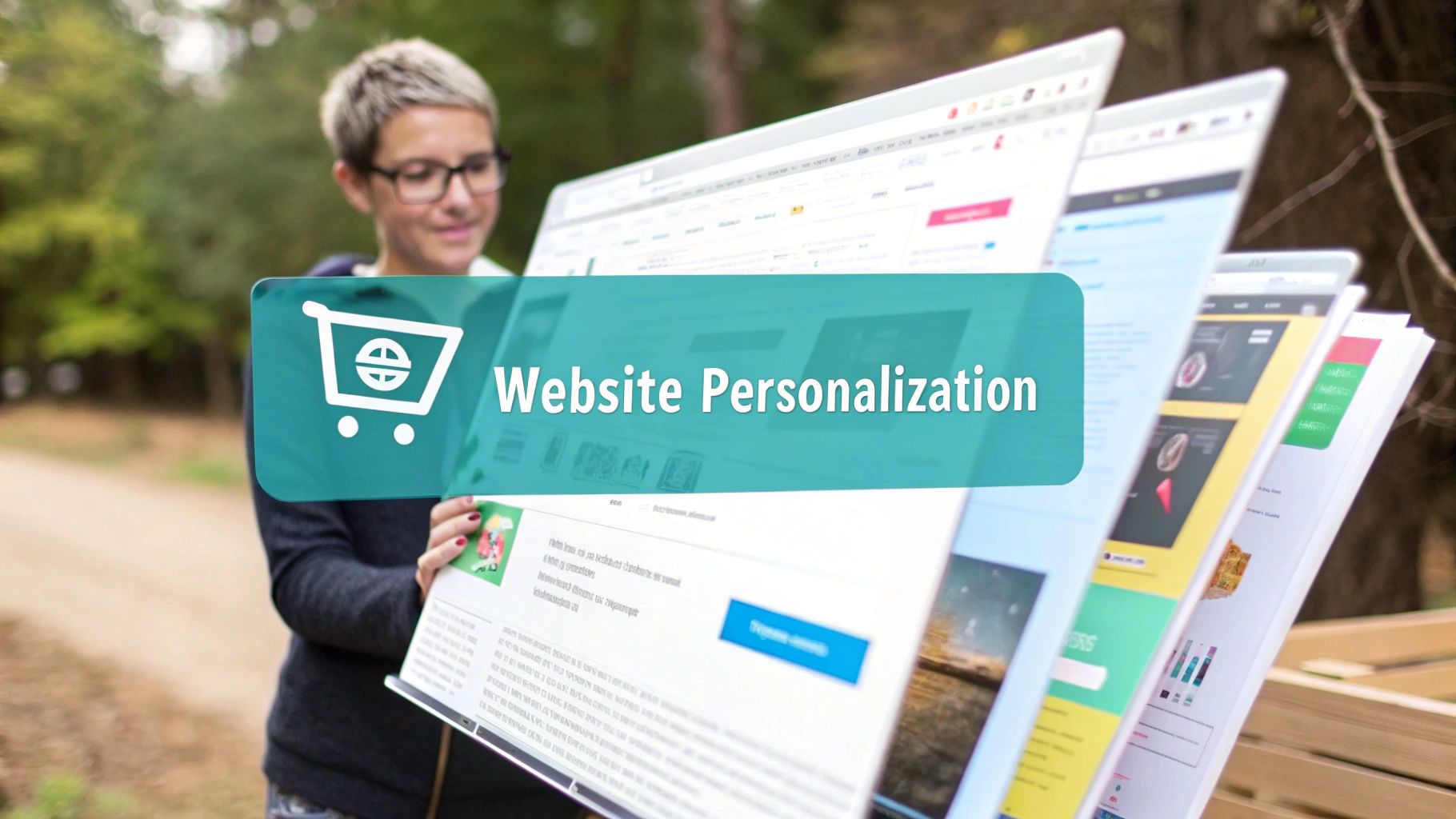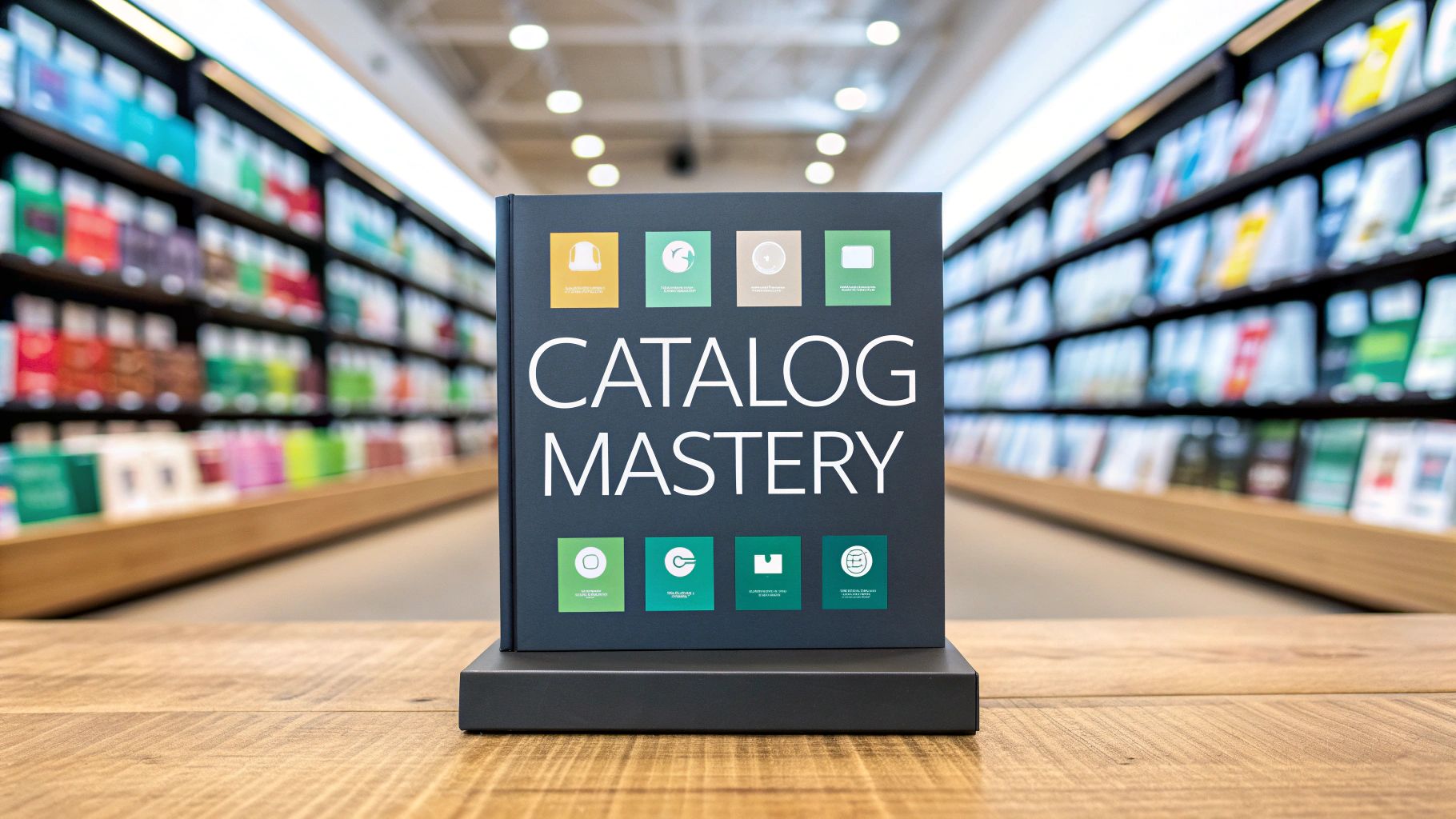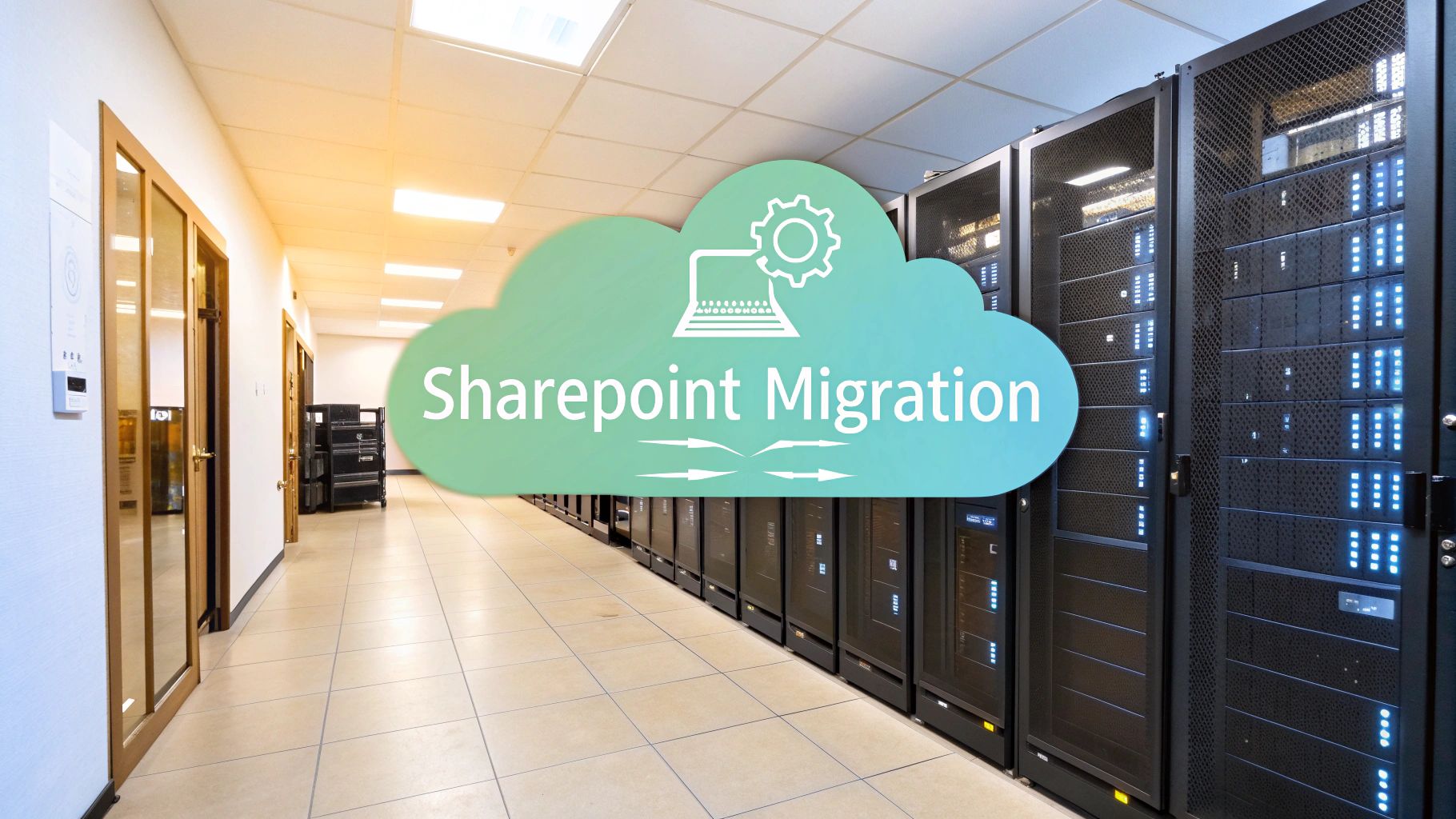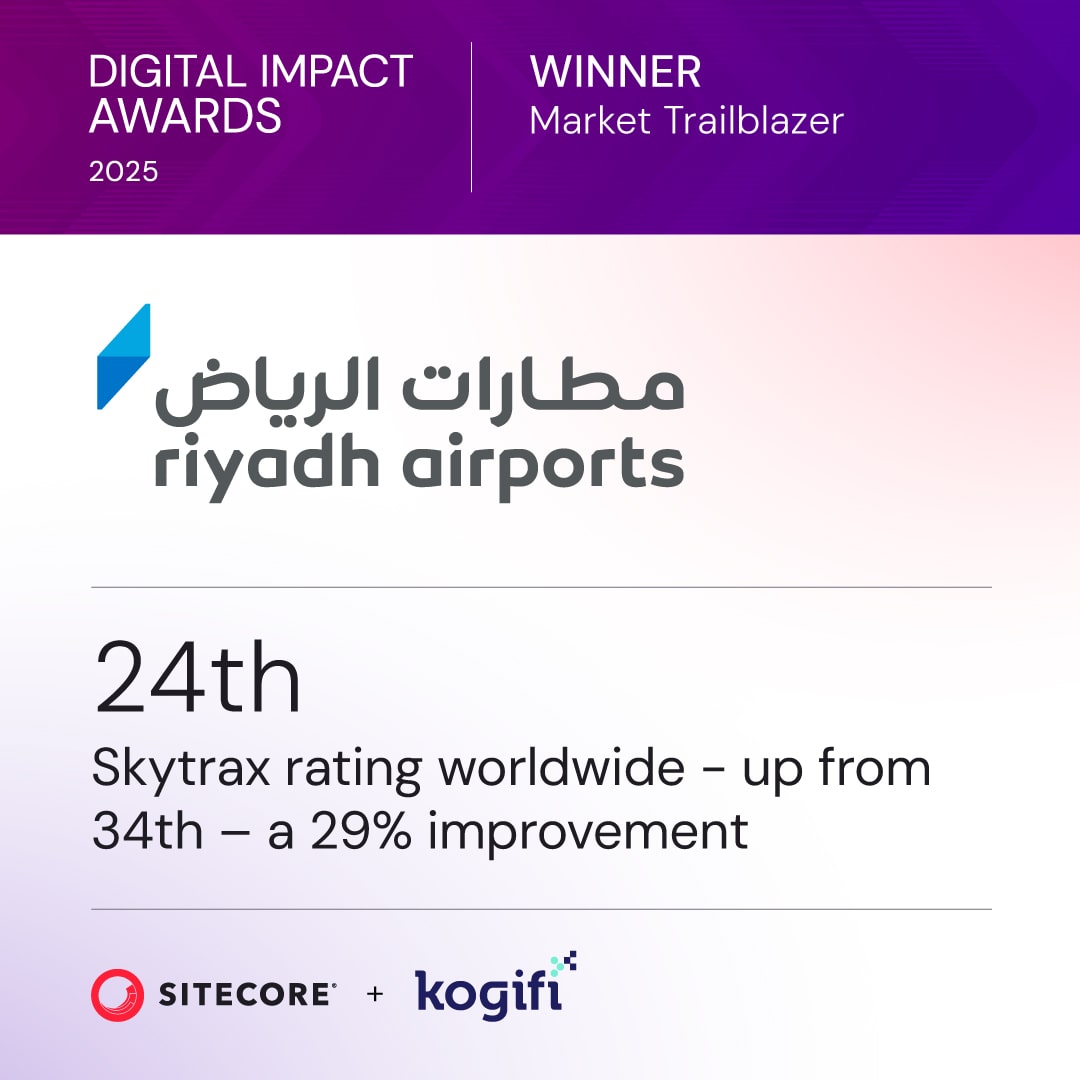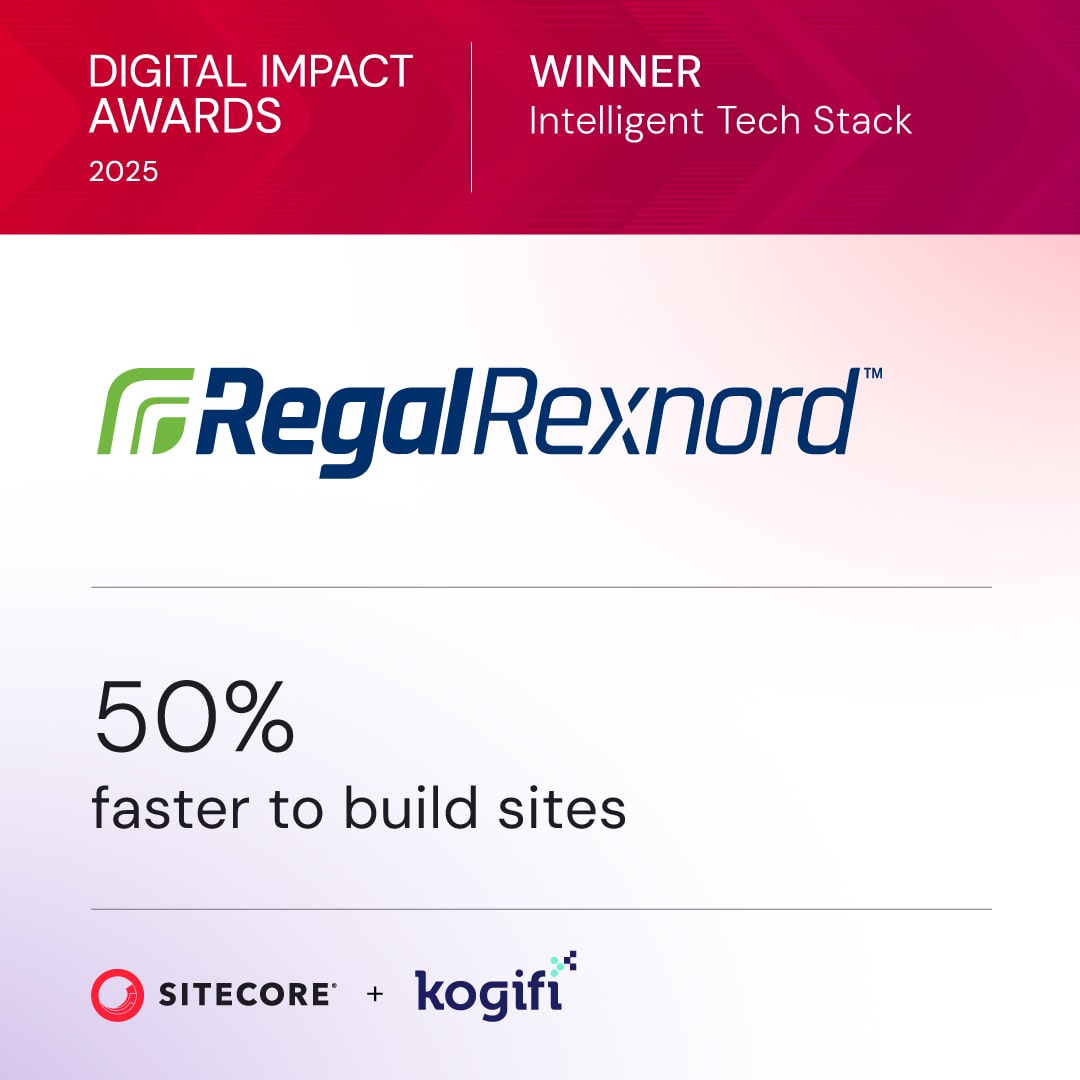A Content Management System (CMS) is the software that lets you create, manage, and modify the digital content on your website without having to mess with code. Think of it as the mission control for your entire digital presence, giving your team the power to publish and update information on the fly.
Understanding Your Digital Command Center
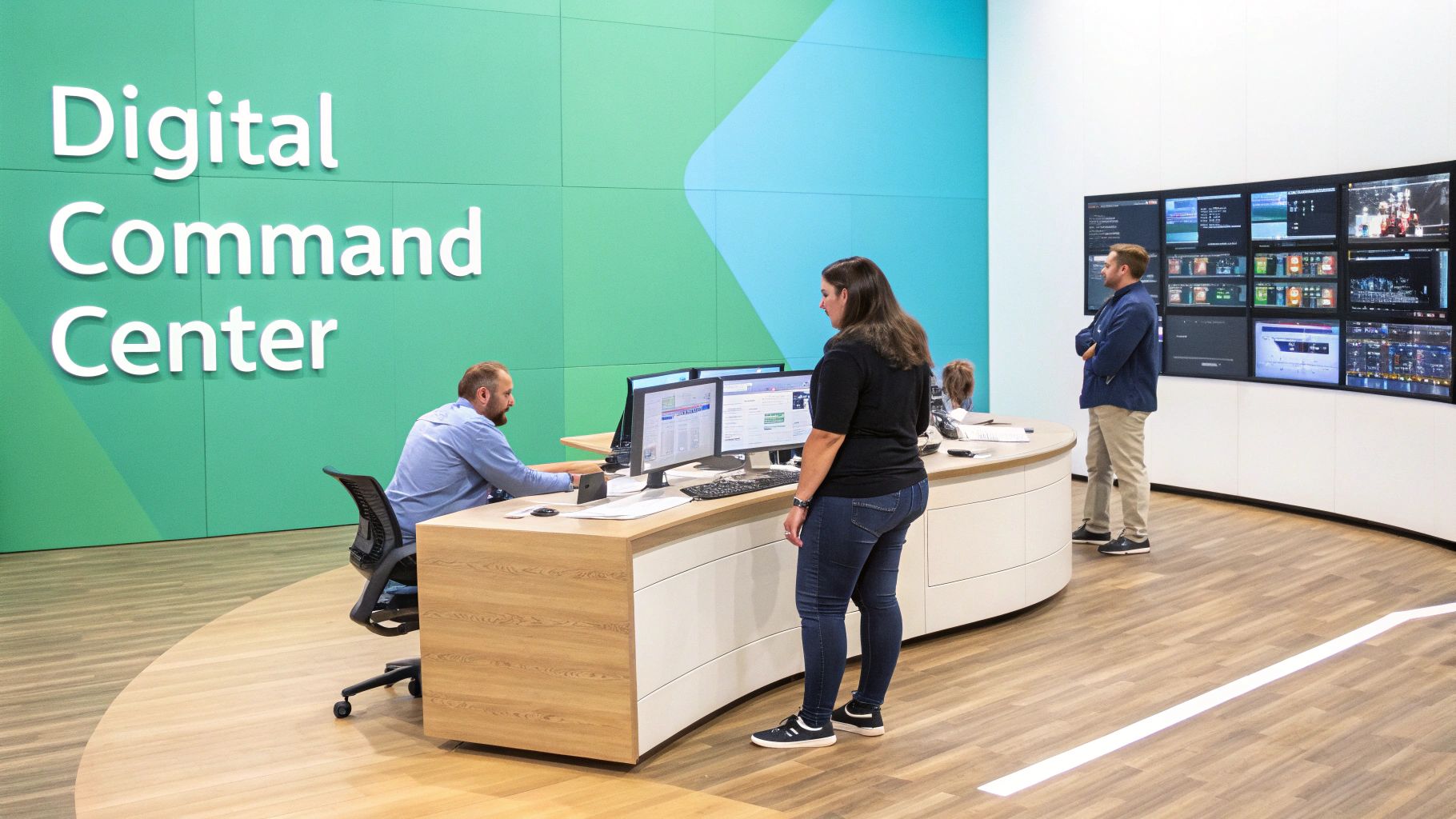
Imagine trying to run a digital newsroom. You’ve got writers crafting articles, editors reviewing them, and graphic designers creating visuals—all while a publisher makes sure everything goes live on time. Without a central system, it would be pure chaos. A jumble of emails, shared documents, and manual file uploads.
This is the exact problem a CMS platform solves for your business.
It provides a single, unified interface where everyone on your team, from marketers to developers, can collaborate seamlessly. Marketers can draft blog posts in an editor that feels as simple as a word processor. Editors can then jump in to review, suggest changes, and approve the content, all within the same system.
The Evolution from Tool to Experience Engine
Early on, a CMS was just a basic tool for website management. Its main job was to separate the content (your text and images) from the design (the website's layout and style). This was a huge leap forward because it meant you could update a webpage without needing to write a single line of code.
But the role of a CMS has exploded since then. Today’s advanced platforms, like those built with Sitecore, are less about managing pages and more about orchestrating entire digital experiences. They’re the engines that power sophisticated, personalized customer journeys from start to finish.
The move toward cloud-based solutions has pushed this change even further, offering incredible flexibility and scale. You can dig deeper into these modern systems in our complete guide to cloud-based CMS.
A modern CMS is no longer just a backend tool for your website. It's the strategic foundation that connects your content, data, and marketing efforts to create meaningful interactions with your audience across every digital touchpoint.
To get a clearer picture, let's break down the fundamental jobs a CMS handles. These pillars are what make it such an essential piece of business technology.
Core Functions of a Modern CMS at a Glance
These core functions work together to create a powerful, centralized hub that simplifies what would otherwise be a messy, technical, and time-consuming process.
The Widespread Impact of CMS Platforms
The importance of these platforms is impossible to ignore when you look at the modern web. CMS technology has become foundational, powering a huge majority of all websites online.
Projections show that by 2025, roughly 68.7% of websites will use some form of CMS, with the market expected to hit $23.17 billion. These numbers aren't just trivia; they highlight the critical role these systems play in helping organizations of all sizes manage their digital footprint effectively. This is why understanding what is a CMS platform is no longer optional for any business that wants to succeed online.
The Journey From CMS to Digital Experience Platform
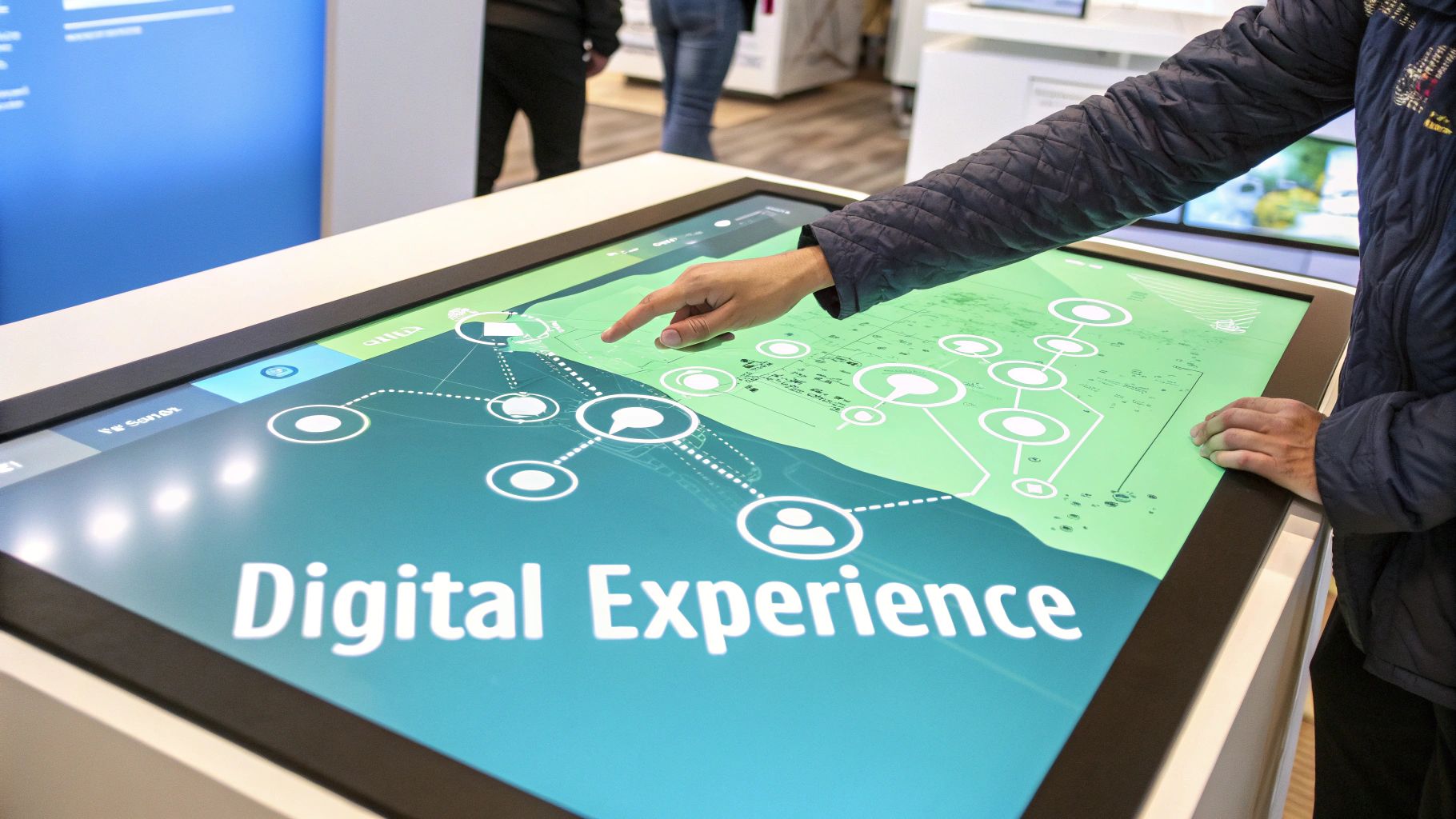
A quick look at Sitecore's interface tells you everything you need to know about where the industry is heading. It’s all about creating connected experiences, not just managing content. This visual really drives home the shift from a basic CMS to a platform that powers personalized customer interactions.
Let’s be honest: just managing content isn't enough to cut it anymore. Customers expect seamless, personalized interactions at every single touchpoint. This expectation has forced a massive evolution, pushing the standard CMS to become a much more powerful Digital Experience Platform (DXP).
Think of it this way: if a CMS is the factory that produces and stores your content, a DXP is the entire intelligent supply chain that delivers that content to the right person at the right time.
This evolution is perfectly captured by platforms like Sitecore, which have been at the forefront of this move toward integrated digital ecosystems. A DXP doesn't just hold onto your content; it weaves together customer data, analytics, and e-commerce into one cohesive fabric. To get a better handle on this, you can check out our detailed guide on what is a digital experience platform.
Beyond Pages to People
The real game-changer here is a fundamental shift in focus. We've moved from managing static web pages to orchestrating dynamic, data-driven interactions that are tailored to individual users. Where a traditional CMS sees an anonymous visitor, a DXP sees a unique customer with a history, preferences, and intent.
Sitecore’s product lineup is a masterclass in this concept. It goes way beyond the core CMS, offering specialized tools designed to understand and engage customers on a much deeper level.
- Sitecore Experience Platform (XP): This combines the CMS with marketing automation and analytics, letting you track user behavior and serve up personalized content on the fly.
- Sitecore Experience Commerce (XC): This fully integrates content and commerce. It allows you to create fluid shopping experiences where product information and marketing messages work hand-in-hand.
These tools transform a website from a simple digital brochure into an intelligent sales and marketing engine that adapts to every single visitor.
The Power of Data and Personalization
At the very heart of a DXP like Sitecore is the ability to collect and, more importantly, activate customer data. This is where a dedicated tool like a Customer Data Platform (CDP) becomes absolutely essential.
A CDP acts as the central brain of the operation, pulling together customer data from all over the place—your website, mobile app, CRM, and even in-store purchases. Sitecore CDP, for instance, builds a persistent, unified profile for each customer. This rich, detailed data is the fuel for the personalization engine.
A DXP uses data to answer not just "what content do we have?" but "who is this person, and what content do they need right now?" This capability is what transforms a simple interaction into a memorable experience.
With a tool like Sitecore Personalize, you can use these detailed customer profiles to run sophisticated A/B tests, trigger personalized offers, and tailor entire user journeys across different channels. This is exactly how brands create the seamless, omnichannel experiences customers now demand, building loyalty and driving conversions in the process. While Sitecore manages these external experiences, platforms like SharePoint often handle the internal collaboration needed to produce the content, acting as a crucial part of the broader enterprise digital strategy.
Decoding the Features of an Enterprise CMS
When your business is operating at a global scale, a basic content tool just isn't going to cut it. This is where an enterprise CMS comes in. Think of it as a powerhouse designed for complexity—it's built to juggle global operations, intricate marketing campaigns, and sophisticated digital strategies all at once. Unlike simpler systems, it’s engineered to handle immense volume, multiple brands, and deep personalization demands.
This distinction is a big deal in the market. Large enterprises dominate CMS usage, holding a market share of about 67.3%, and they rely on these advanced systems to streamline content management. They also need them to talk to their other core business tools, like ERPs and marketing automation platforms. You can learn more about these market trends and CMS adoption if you want to dive deeper.
A true enterprise platform like Sitecore isn't just about creating content. It provides a whole suite of features that directly tackle the challenges of large-scale digital operations.
Sophisticated Workflows and Governance
For a global brand, publishing content is rarely as simple as hitting a "publish" button. Content often needs to get sign-off from legal, brand, and regional review teams first. An enterprise CMS brings sophisticated content workflows to the table to manage this exact process.
You can set up multi-step approval chains that automatically send content to the right stakeholders for review. This ensures every single piece of content is properly vetted and compliant before it ever goes live, which minimizes risk and keeps your brand consistent across all your digital properties.
Advanced Personalization and A/B Testing
Delivering experiences that feel tailored to each user is no longer a "nice-to-have"—it's an expectation. Enterprise platforms like Sitecore really shine here, offering powerful tools for both personalization and optimization.
- Rule-Based Personalization: You can create rules to display different content based on a user's location, the device they're on, or their browsing history.
- A/B and Multivariate Testing: Marketers can test different versions of headlines, images, or calls-to-action to see what actually works best with specific audience segments.
This data-driven approach shifts marketing from guesswork to a science. It gives teams the ability to optimize every interaction for maximum impact. To see how this fits into the bigger picture, explore our guide on the benefits of enterprise content management.
Multisite Management for Global Brands
Trying to manage dozens—or even hundreds—of websites for different regions, brands, or product lines would be a logistical nightmare with a standard CMS. Enterprise platforms solve this headache with robust multisite management.
From a single dashboard, you can oversee multiple websites while sharing content, templates, and digital assets between them. This capability is non-negotiable for global companies aiming to maintain brand consistency while allowing for regional customization.
For instance, a company might use a SharePoint solution as the internal backbone for document management, feeding approved assets into a public-facing DXP like Sitecore. This creates a cohesive ecosystem where internal processes smoothly support external customer experiences.
Ultimately, these are the kinds of enterprise-grade features that transform a CMS from a simple website tool into a strategic asset for scaling operations and delivering a truly targeted digital experience.
Exploring Different CMS Architectural Models
Not all CMS platforms are built the same. The architecture under the hood is what dictates how a system stores, manages, and ultimately delivers your content. This choice has a massive impact on everything from flexibility and scalability to how your developers and marketers actually use the platform day-to-day.
Getting a handle on the main models—traditional, headless, and composable—is the first step to picking a platform that won't hold you back in the long run.
Traditional vs. Headless vs. Composable
A traditional CMS, often called a monolithic system, bundles everything into a single package. The back-end (where you create and store content) is tightly fused with the front-end (the website your visitors see). This all-in-one approach is simple and works great for straightforward websites, but that tight integration can become a real headache when you want to push content to a mobile app, a smart device, or any other channel. It often requires a complete overhaul.
In a direct response to those limitations, the headless CMS emerged. It completely decouples the back-end "body" from the front-end "head." This model acts as a pure content repository, serving up raw content through APIs to any front-end you can dream up—a website, an IoT device, or even a digital kiosk. It gives developers incredible freedom, though it can sometimes leave marketers feeling a bit disconnected since there's no built-in "what you see is what you get" preview.
If you want to dig deeper into the nuances, we've got a full breakdown in our headless CMS vs traditional CMS comparison.
The most modern approach today is the composable DXP. Championed by platforms like Sitecore, this philosophy aims to give you the best of both worlds: the freedom of headless delivery combined with the powerful, intuitive authoring tools marketers love from traditional systems.
With a composable architecture, businesses can 'compose' their ideal digital stack by integrating best-of-breed services via APIs. This means you can plug in your preferred e-commerce engine or search tool without being locked into a single vendor's suite.
This model is a strategic answer to a market that demands agility. While many systems exist, enterprises are increasingly shifting toward flexible SaaS platforms that offer these newer headless and composable capabilities to build truly tailored digital ecosystems.
Comparing CMS Architectural Models
To make sense of these options, it helps to see them side-by-side. Each model serves a different purpose, and the right choice depends entirely on your team's skills, your business goals, and how you plan to grow.
This table clarifies that there's no single "best" architecture—only the one that's best for you.
Integrating Internal and External Content Hubs
In any large organization, the digital ecosystem is much bigger than just the public-facing website. This is where a platform like SharePoint plays a crucial, complementary role. While a DXP like Sitecore is engineered to manage and deliver personalized external customer experiences, SharePoint shines as a powerful internal hub for content and knowledge management.
This infographic breaks down the core features you’d expect from an enterprise-grade CMS, like advanced workflows, personalization engines, and multisite management.

These are the capabilities that form the backbone of a sophisticated digital strategy, allowing you to orchestrate content at scale. By integrating an external-facing DXP with an internal collaboration tool, enterprises create a seamless flow of information—from internal creation to external delivery—ensuring both consistency and efficiency across the board.
How to Choose the Right CMS for Your Business
Picking a new CMS is a lot more than just a tech upgrade—it’s a major business decision that will define your digital strategy for years to come. The right platform can be an engine for growth, but the wrong one can quickly become a roadblock. Getting this right means having a clear plan that focuses on your long-term goals, not just your immediate pain points.
The first step is a good, hard look at your actual needs. Don't get distracted by shiny features just yet. Instead, start by mapping out your business objectives. Where do you want your digital presence to be in the next five years? Who are you trying to reach, and how are you planning to keep them engaged?
Answering these questions helps you build a strong case for a platform that won't just solve today's problems but will also grow with you. For instance, if your vision involves deep personalization and a seamless experience across every channel, you’ll want to look at a composable system like Sitecore. Its entire architecture is designed to adapt, letting you plug in best-in-class tools as your strategy gets more sophisticated.
Evaluating Key Technical and Business Factors
Once you’ve got your strategy straight, it's time to start looking at what different platforms can actually do. This is where you separate the real contenders from the all-talk-no-action pretenders.
Your evaluation should really boil down to a few critical areas:
- Scalability: Can this platform actually keep up as you grow? Think beyond just handling traffic spikes. You need to know if it can manage multiple sites, brands, or regions from one place—a core strength of platforms like Sitecore and SharePoint when they're used for external and internal content, respectively.
- Integration Capabilities: Your CMS won’t be working alone. It needs to play nicely with the rest of your tech stack, from your CRM and ERP to your marketing automation tools. A composable DXP is built with API-first integrations in mind, giving you the flexibility to create a truly connected digital ecosystem.
- Total Cost of Ownership (TCO): Don't just look at the price tag. You need to factor in the cost of implementation, ongoing maintenance, team training, and any future upgrades. A clear picture of the TCO is the only way to avoid nasty budget surprises down the road.
- Security Standards: In a world of constant digital threats, solid security is non-negotiable. Dig into the platform’s security protocols, find out what compliance certifications it holds, and check its track record for protecting enterprise-level data.
For businesses that are just getting started or looking to sharpen their digital edge, understanding the different options is everything. You can dive deeper into what to look for when choosing the best CMS platforms for small businesses.
A Checklist for Vendor Discussions
Walking into a conversation with a vendor without a clear list of questions is like trying to navigate without a map. To make sure you’re in the driver’s seat, use this checklist to guide your discussions and get the answers you actually need.
An informed choice is an empowered one. The goal is to select a partner and a platform that aligns with your business's trajectory, not just its current state.
Here are the key questions you should be asking:
- Roadmap and Vision: Where is your platform headed in the next 3 to 5 years? How do you support a composable strategy?
- Authoring Experience: How intuitive is the content creation and editing process for non-technical marketing teams? Can they work without a developer holding their hand?
- Support and Community: What level of technical support comes standard? How active and helpful is your developer and user community?
- Implementation Partners: Who are your certified partners with a proven track record in our industry?
- Upgrade Path: What does a major platform upgrade look like, and what are the typical costs involved?
With these insights in hand, you'll be in a much better position to choose a CMS that not only handles what you need today but also serves as a solid foundation for your digital growth tomorrow.
Got Questions About Your CMS? We've Got Answers
As you start digging into the world of content management, a few big questions always pop up. It's totally normal, especially when you're making strategic decisions that will shape your business for years to come. Let's tackle the most common ones head-on, focusing on how enterprise platforms like Sitecore fit into the bigger picture.
What Is the Difference Between a CMS and a DXP?
Think of a Content Management System (CMS) as the foundational tool for your website. It's built to do one thing really well: help you create, manage, and publish digital content. It’s the engine room for your website's articles, images, and pages.
A Digital Experience Platform (DXP), on the other hand, is the whole ship. It takes the core engine of a CMS and surrounds it with a suite of powerful tools designed for personalization, customer data management, and delivering content across any channel you can think of—not just your website.
The real difference is the focus. A CMS manages content. A DXP like Sitecore uses that content to build and guide personalized customer journeys. It taps into deep customer insights from tools like Sitecore CDP to deliver one-of-a-kind experiences, turning static web pages into dynamic, individual conversations.
Why Is a Composable Architecture So Important Today?
In a market that changes by the minute, being agile isn't just a buzzword—it's a survival tactic. A composable architecture is what gives you that agility. Instead of being stuck with a single, massive software suite that does everything "okay," you get to build your own perfect tech stack. You can pick the absolute best tools for each job—like search, e-commerce, or analytics—and connect them all seamlessly with APIs.
For a platform like Sitecore, this means you're no longer boxed in. You have the freedom to assemble a digital experience setup that is perfectly tailored to how your business actually works.
This 'pick-and-choose' model is a game-changer. It lets you adopt new technologies as they appear without being chained to one vendor. It’s how you future-proof your digital strategy, making sure your platform can grow right alongside your business.
This flexibility is the modern answer to the old, clunky, all-in-one systems. It gives you the freedom and scalability you need to stay ahead of the curve.
How Does SharePoint Fit Into an Enterprise CMS Strategy?
It's a common point of confusion, but SharePoint and a public-facing DXP like Sitecore actually play for the same team—they just have different positions on the field. Sitecore is your star forward, engineered to create and personalize the external customer experiences your audience sees on the web, mobile apps, and other digital channels.
SharePoint is your rock-solid defense, an internal collaboration and document hub. Think of it as your company's digital headquarters or intranet.
It's the central place for managing internal knowledge, streamlining team workflows, and keeping documents secure. In a smart enterprise strategy, SharePoint is the official source of truth for all your corporate assets and approved content. That content can then be fed directly into a DXP like Sitecore. This integration creates a seamless digital ecosystem where everything is consistent and on-brand, ensuring the great work you do internally translates directly into an exceptional experience for your customers.
At Kogifi, we don't just implement software; we build integrated DXP and CMS solutions that power real business growth. Our expert teams for Sitecore and SharePoint are ready to help you build a digital foundation that’s as powerful as it is flexible. Get in touch to learn more.






















